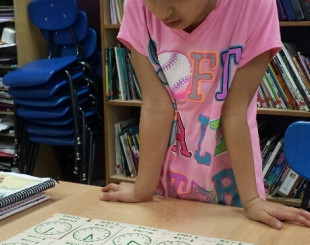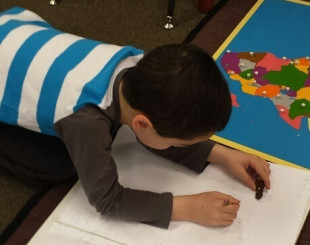The best way to understand the Montessori method is to observe in the classrooms. Please call 773.714.0646 or email for more information or to make an appointment.
Observation is the cornerstone for connecting the students to our carefully prepared Montessori classrooms. We invite our families to observe their student prior to conferences and in preparation for transitions from one program level to the next. In addition, our parents stay connected to the classroom happenings through weekly blog entries, often viewing them with their children to encourage sharing about their days. Here are samples of typical blogs:
On the Job Training
“Never help a child with a task at which he feels he can succeed.”
Dr. Maria Montessori
 Along with getting back into classroom routines this week, we began job training. Our carefully prepared and organized classroom takes great effort to keep tidy. Once the job training period is complete, each student will be assigned specific tasks to help maintain our environment. This allows the students to see how they affect their surroundings. They can see what happens when paper towels are left in the sink, work is out of place and crumbs collect on the floor. This experience gives them a sense of ownership as each member of the class must complete their job for our classroom to remain orderly. The jobs change on a monthly so basis so everyone has a chance to have a variety of different positions through the year. One month your child may hold a Quality Control position where they are responsible for managing a small group of students and in another month, they may be in charge of sweeping the tile.
Along with getting back into classroom routines this week, we began job training. Our carefully prepared and organized classroom takes great effort to keep tidy. Once the job training period is complete, each student will be assigned specific tasks to help maintain our environment. This allows the students to see how they affect their surroundings. They can see what happens when paper towels are left in the sink, work is out of place and crumbs collect on the floor. This experience gives them a sense of ownership as each member of the class must complete their job for our classroom to remain orderly. The jobs change on a monthly so basis so everyone has a chance to have a variety of different positions through the year. One month your child may hold a Quality Control position where they are responsible for managing a small group of students and in another month, they may be in charge of sweeping the tile.
Today, we practiced dusting and straightening all of the shelves. Next week, we will practice washing the tables, taking care of the plants and our turtle, Pokey, and sweeping and vacuuming. Remember that the students can practice these life skills at home too!
Inspiration to seek knowledge
“The secret of success is found to lie in the right use of imagination in awakening interest, and the stimulation of seeds of interest already sown by attractive literary and pictorial material, but all correlated to a central idea, of greatly ennobling inspiration…”
Dr. Maria Montessori, To Educate the Human Potential
 The Montessori materials were designed by Maria Montessori to be visually appealing to children. Her hope was that the visual appeal would inspire the child’s desire to touch and use them. Dr. Montessori also stressed the importance of the natural world to inspire children to explore and make new discoveries to further understand the world around them.
The Montessori materials were designed by Maria Montessori to be visually appealing to children. Her hope was that the visual appeal would inspire the child’s desire to touch and use them. Dr. Montessori also stressed the importance of the natural world to inspire children to explore and make new discoveries to further understand the world around them.
In Children’s House the students strive to understand their immediate environment: how to use objects they see adults using, what are the names of things? When students transition into Elementary, they move beyond their home environment and find their place within their culture. When Maria Montessori referred to culture in this context, she meant mastering the child’s native language, adapting writing structures for both letters and numbers commonly used, continued practice with grace and courtesy, and satisfying their strong sense of justice. Since elementary students have the capacity to learn to read, this ability expands their imagination further and provides them with the ability to make discoveries on their own.
Experiencing a walk around the neighborhood, a bike ride, a museum, or a live performance with your child are wonderful ways to spark their imaginations and grow their curiosities.

